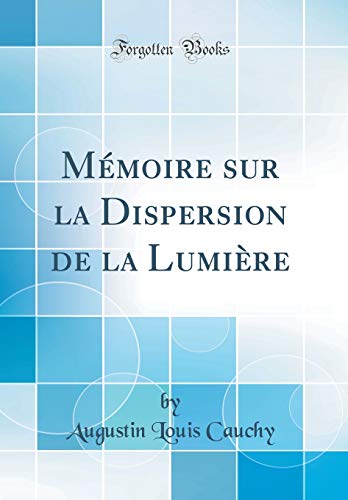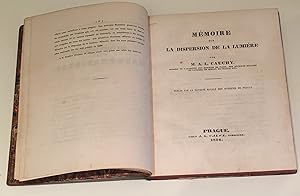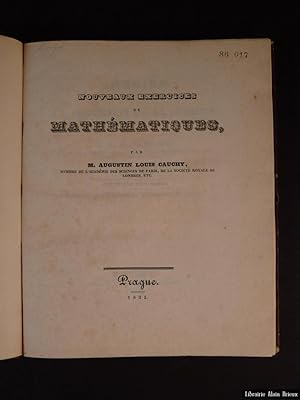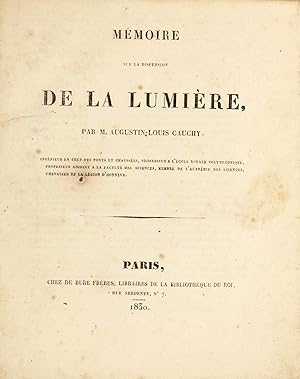mémoire dispersion lumière de cauchy augustin (7 résultats)
Type d'article
- Tous les types d'articles
- Livres (7)
- Magazines & Périodiques
- Bandes dessinées
- Partitions de musique
- Art, Affiches et Gravures
- Photographies
- Cartes
-
Manuscrits &
Papiers anciens
Etat
Reliure
Particularités
- Edition originale (3)
- Signé
- Jaquette
- Avec images (6)
- Sans impression à la demande (5)
Pays
Evaluation du vendeur
-
Memoire sur la dispersion de la lumiere - (1836) [LeatherBound]
Date d'édition : 2023
Vendeur : True World of Books, Delhi, Inde
Livre impression à la demande
LeatherBound. Etat : NEW. LeatherBound edition. Condition: New. Reprinted from 1836 edition. Leather Binding on Spine and Corners with Golden leaf printing on spine. Bound in genuine leather with Satin ribbon page markers and Spine with raised gilt bands. A perfect gift for your loved ones. NO changes have been made to the original text. This is NOT a retyped or an ocr'd reprint. Illustrations, Index, if any, are included in black and white. Each page is checked manually before printing. As this print on demand book is reprinted from a very old book, there could be some missing or flawed pages, but we always try to make the book as complete as possible. Fold-outs, if any, are not part of the book. If the original book was published in multiple volumes then this reprint is of only one volume, not the whole set. Sewing binding for longer life, where the book block is actually sewn (smythe sewn/section sewn) with thread before binding which results in a more durable type of binding. Pages: 248.
-
Memoire sur la dispersion de la lumiere par M. AugustinLouis Cauchy . [LeatherBound]
Date d'édition : 2023
Vendeur : True World of Books, Delhi, Inde
Livre impression à la demande
LeatherBound. Etat : New. Leather Binding on Spine and Corners with Golden leaf printing on spine. Bound in genuine leather with Satin ribbon page markers and Spine with raised gilt bands. A perfect gift for your loved ones. Reprinted from 1830 edition. NO changes have been made to the original text. This is NOT a retyped or an ocr'd reprint. Illustrations, Index, if any, are included in black and white. Each page is checked manually before printing. As this print on demand book is reprinted from a very old book, there could be some missing or flawed pages, but we always try to make the book as complete as possible. Fold-outs, if any, are not part of the book. If the original book was published in multiple volumes then this reprint is of only one volume, not the whole set and contains approximately 31 pages. IF YOU WISH TO ORDER PARTICULAR VOLUME OR ALL THE VOLUMES YOU CAN CONTACT US. Resized as per current standards. Sewing binding for longer life, where the book block is actually sewn (smythe sewn/section sewn) with thread before binding which results in a more durable type of binding. Language: French.
-
Mémoire sur la Dispersion de la Lumière (Classic Reprint)
Edité par Forgotten Books, 2017
ISBN 10 : 0331073544ISBN 13 : 9780331073546
Vendeur : Buchpark, Trebbin, Allemagne
Livre
Etat : Sehr gut. Zustand: Sehr gut - Gepflegter, sauberer Zustand. | Seiten: 242.
-
Mémoire sur la Dispersion de la Lumière
Edité par Prague: J. G. Calve, 1835
Vendeur : Landmarks of Science Books, Richmond, Royaume-Uni
Livre Edition originale
Hardcover. Etat : Very Good. 1st Edition. First edition of the memoir in which Cauchy explained the dispersion of light from the undulatory theory, and first derived the equation, named after him, relating the refractive index and wavelength of light for a particular transparent material. This memoir was issued as eight parts of his periodical 'Nouveaux Exercices de Mathématiques' (see below). "The dispersion of light when passing through matter without getting fully absorbed, i.e., the variation of the refractive index n (which denotes the ratio of the velocity of light in vacuo to the velocity of light in matter) with the wavelength, always played an important role in the history of optics since the times of Isaac Newton. After the undulatory theory of light won over the corpuscular view in the beginning of the nineteenth century, Augustin-Louis Cauchy proposed an explanation of the dispersion phenomenon, based on the assumption that matter consisted of molecules having finite distances from each other [the offered work]. According to his theory the refractive index n increased with decreasing wavelength of the light - n was approximately proportional to the inverse square of the wavelength - in general agreement with the data on what was later called 'normal' dispersion" (Mehra & Rechenberg, p. 630). In his publication Cauchy nowhere referred for inspiration to Augustin-Jean Fresnel, the originator in France of wave optics. Instead, he wrote that Gustave-Gaspard Coriolis, having read Cauchy's earlier work on the equations of motion that govern a system of material points, suggested that terms which Cauchy had there neglected might account for dispersion. "Cauchy's mathematics for dispersion set a programme of research that was pursued in France, Britain, and Germany during the 1830s and (in Germany and France) into the 1850s. During the 1830s, in fact, optical theory became for a time nearly synonymous with Cauchy's ether dynamics" (Buchwald, p. 461). Cauchy's dispersion formula works reasonably well for normally dispersive bodies and was only replaced towards the end of the 19th century following the discovery of anomalous dispersion by the Danish physicist Christian Christiansen in 1870 and consequent changes in theory by Wolfgang Sellmeier and Hermann von Helmholtz in Germany. The present memoir is a continuation and expansion of his earlier work, of the same title, published in Paris in 1830; the earlier work did not contain Cauchy's dispersion formula. In 1826 Cauchy began to publish his 'Exercises de Mathematiques', which was essentially a mathematical periodical consisting entirely of papers written by himself; it appeared at approximately monthly intervals until 1830. He used similar series as vehicles for his publications at later stages of his career; the 'Nouveaux Exercices de Mathématiques' were published in Prague in 1835-36 and the 'Exercices d'Analyse et de Physique Mathématique' appeared at intervals from 1840 to 1853" (Smithies, p. 113). Buchwald, 'Optics in the nineteenth century,' in The Oxford Handbook of the History of Physics (Buchwald & Fox, eds.), 2013. Mehra & Rechenberg, The Historical Development of Quantum Theory, Vol. 1, Part 2, 1982. Smithies, Cauchy and the Creation of Complex Function Theory, 1997. 4to (259 x 202 mm), pp. [iv, title and foreword of the Nouveaux Exercices], iv [title and foreword of the Mémoire], 236 (a few leaves foxed). Contemporary half-calf over marbled boards, marbled end papers, engraved bookplate to front paste down (rubbed).
-
Couverture rigide. Etat : Bon. IV-236 pages Prague, chez J.G. Calve, 1836, in-4, IV-236 pages, demi-chagrin havane, dos à faux nerfs, Première édition séparée. Important ouvrage dans lequel Cauchy (1789-1867), à la suite de Fresnel, explique la dispersion de la lumière selon la théorie ondulatoire. Il a paru à l'origine en 8 livraisons dans les Nouveaux exercices de mathématiques en 1835; il s'inscrit dans la continuité ses travaux précédents, publiés à Paris en 1830. Ce mémoire a paru quant à lui à Prague, où le mathématicien était précepteur du duc de Bordeaux en exil. Titre et avant-propos des Nouveaux exercices de 1835 rajoutés parmi les feuillets liminaires. Étiquette ex-libris Henri Viellard. Cachets de l'Institut catholique annulé. Petits manques au dos, charnières frottées. Étiquette en pied du dos. Quelques feuillets fortement brunis, rousseurs. DSB III, p. 131 et suiv.
-
Mémoire sur la dispersion de la lumière.
Edité par Chez de Bure frères, Paris, 1830
Vendeur : Milestones of Science Books, Ritterhude, Allemagne
Livre Edition originale
Hardcover. Etat : Very Good. 1st Edition. Important Sammelband on light and astronomy, including Cauchy's 1830 Memoir on dispersion: CAUCHY, Augustin-Louis. Mémoire sur la dispersion de la lumière, Paris: Chez de Bure frères, 1830. 4to (257 x 204mm). [2], 24 pp. [Bound with:] II. STEVENSON, Alan. Observations on the Application of Catadioptric Zones to Lights of the First Order in the System of Fresnel. Edinburgh: Neill & Co., 1840, 12, [4] pp., 1 plate. One engraved plate (slight marginal browning). [Bound with:] III. HERSCHEL, William. Observations of a Second Comet, with remarks on its construction. Extract from Philosphical Transactions, [London, 1812, Vol. 102], pp.229-237. [Bound with:] IV. HERSCHEL, William. Experiments for Ascertaining how far Telescopes will enable us to determine very small angles, and to distinguish the real from the Spurious Diameter of celestial and terrestrial Objects. Extract from Philosphical Transactions, [London, 1805, Vol. 95], pp. 31-64. Lacking plate. [Bound with:] V. CAVENDISH, Henry. Experiments to Determine the Density of the Earth. Extract from Philosophical Transactions. [London, 1798, Vol. 88], 469-526, 2 folding engraved plates (slightly foxed). [Bound with:] VI. DOWNES, Olinthus Gregory. On the Physical Constitution of Comets. London: C. & E. Layton, 1860. [4], 45 [1] pp, half-title, 3 lithographed plates. [Bound with:] VII. FORBES, James D. Bakerian Lecture - On the Transparency of the Atmosphere and the Law of Extinction of the Solar Rays in passing through it. Extract from Philosophical Transactions. [London, 1842], pp. 225-273 [1], 9 plates, 6 folding (slight browning and some marginal dampstaining). [Bound with:] VIII. AIRY, George Biddell. The Bakerian lecture - On the Theoretical Explanation of an apparent new Polarity in Light. Extract from: Philosophical Transactions. [London, 1840], pp. 225-244. Folding plate. All bound in later blue pebbled cloth, spine with gilt lettering and printed paper label (hinges and spine repaired). Little age browning of text and plates, first title with clean tear repaired. ---- EXCEPTIONALLY RARE FIRST EDITION of the Memoir in which Cauchy first explained the dispersion of light from the undulatory theory of light. On June 7 and 14, 1830, three years after Fresnel's death, Cauchy presented a comparatively short (given his customary standards) memoir on light before the Académie in Paris, which appeared there after in the Bulletin de Férussac; he also had it printed separately by de Bure Frères . Then, after the appearance in 1830 of the Memoir on light that he had presented on June 14 of that year before the Académie, Cauchy published one further paper on light in Férussac, and nothing more until 1835. We do however know that at the time of his June 14 presentation he also announced to the Académie that he 'had the formulas relative to the dispersion of light that he had read at the last session.' The Procès Verbaux for the meeting accordingly noted that Cauchy had presented a memoir 'on the subject.' (J.Z. Buchwald, Chapter 22 - Cauchy's Theory of Dispersion Anticipated by Fresnel). In 1830, using the discrete model of a medium (ether), Cauchy tried to explain dispersion of the light under the assumption that the light represents elastic waves with a very large frequency. He showed that for wavelengths that are much greater than the distance between the neighbouring particles in the one-dimensional lattice, the wave velocity does not depend on the wavelength. However, for the short wavelengths, that is, for high frequencies, the wave velocity is a function of wavelength and can vary essentially. Cauchy reprinted the Memoir of 1830 during his stay in Prague in 1835 and further expanded his theory in successive Memoirs published in Prague between 1835 and 1836. - Visit our website for additional images and information.
-
[Set of Nineteenth-Century Scientific and Mathematical Treatises]: Fisica de' Corpi Ponderabili ossia Trattato della Costituzione Generale de' Corpi del Cavaliere (1837-1841); Opuscoli matematici e fisici di diversi autore (1832-1834); Mémoire sur la Dispersion de la Lumière (1835-1836); Traité des fonctions elliptiques et des intégrales eulériennes, avec des Tables pour en faciliter le calcul numérique (1825-1828[-1832]); Géométrie Descriptive (1827); Leçons mécanique analytique l'École polytechnique (1810-1815).
Edité par various places various publishers -1841, 1810
Vendeur : Shapero Rare Books, London, Royaume-Uni
Livre Edition originale
11 vols in all, comprising: I) Fisica de' Corpi Ponderabili: first edition; 4 vols, thick 8vo; 18 folding plates, scattered light foxing, slight toning to leaves; II) Opuscoli Matematici e Fisici: first edition; 2 vols in one, 4to; 2 folding plates, scattered light foxing; III) Mémoire sur la Dispersion de la Lumière: first edition; 4to; numerous tables to text, many full-page, some browning to leaves; IV) Traité des fonctions elliptiques et des intégrales eulériennes: first edition; 3 vols, 4to; 4 folding plates, lacking portrait of Euler in volume 2, some leaves browned, scattered light foxing; V) Géométrie Descriptive: fifth edition; 4to; 28 folding plates, light dampstaining to prelims, scattered light foxing; VI) Mécanique Analytique: first edition; 4to; 4 folding plates, scattered light foxing, light dampstaining to plates; contemporary half vellum (7 vols) and full vellum (4 vols), bound to match, red and green morocco title labels with gilt lettering, gilt tooling to spines, light wear to extremities, overall an attractive set. An attractive set of nineteenth-century scientific and mathematical treatises, bound to match. I) First edition of Avogadro's magnum opus, containing the first announcement of 'Avogadro's Number'. A major treatise containing Avogadro's famous hypothesis that the number of integral molecules in any gas is always the same for equal volumes, or always proportional to the volumes. This was of great importance for nineteenth-century chemistry in effectively distinguishing between atoms and molecules. Avogadro first published this hypothesis in 1811, but it was largely ignored for another half century, partly because it was published first in Italian (when Italy was at the periphery of scientific research) and subsequently only in minor French, German and English scientific journals. II) First edition of this rare publication, considered an important scientific journal above all for being the means of dissemination of the mathematical theories of A.L. Cauchy in Italy. The second volume contains some of Cauchy's fundamental works translated into Italian, including Sulla meccanica celeste. III) First publication of Cauchy's equation, which determined the relationship between the wavelength of light and the refractive index of a material the light passes through. Cauchy produced this publication, which consisted of his own papers, in 1835 and 1836. This memoir was issued as eight parts of his periodical Nouveaux Exercices de Mathématiques, and was a successor to his earlier Exercices de Mathématiques, published from 1826 to 1830. A prolific and rigorous mathematician, Cauchy's works covered refraction and polarization of light, mechanics, elasticity, number theory and complex functions. IV) Rare first edition of Legendre's great work on the theory of elliptic functions, its application to geometry and mechanics, methods of constructing elliptical tables, Eulerian integrals, etc. This copy is complete with the three supplements published successively in 1828, 1829 and 1832. 'Legendre's research covers all areas of mathematics, including celestial mechanics, but his favourite subjects are elliptic functions and number theory. From 1786, he worked with elliptic integrals. His Exercices de calcul intégral (1811-1816) and the three volumes of his monumental Traité des fonctions elliptiques et des intégrales eulériennes (1825-1828), followed by three supplements in which he expounded the work of Abel and Jacobi, made him the undisputed specialist.' (from the French text) V) Fifth edition of this classic work on geometry. 'Monge should be considered the true creator of descriptive geometry, for it was he who elegantly and methodically converted the group of graphical procedures used by practitioners into a general uniform technique based on simple and rigourous geometric reasoning and methods. Within a few years this new discipline was being taught in French scientific and technical schools and had spread to several other Continental countries' (DSB). VI) First edition of this apparently unfinished work on analytical mechanics. Statics and dynamics were to have been augmented with hydrostatics and hydrodynamics, and possibly a fifth part giving applications. Scarce - the two parts are not often found bound together. Norman 89; Honeyman 168 (for Avogadro).


![Image du vendeur pour Memoire sur la dispersion de la lumiere - (1836) [LeatherBound] mis en vente par True World of Books](https://pictures.abebooks.com/inventory/md/md31618816410.jpg)
![Image du vendeur pour Memoire sur la dispersion de la lumiere par M. AugustinLouis Cauchy . [LeatherBound] mis en vente par True World of Books](https://pictures.abebooks.com/inventory/md/md31534240121.jpg)




![Image du vendeur pour [Set of Nineteenth-Century Scientific and Mathematical Treatises]: Fisica de' Corpi Ponderabili ossia Trattato della Costituzione Generale de' Corpi del Cavaliere (1837-1841); Opuscoli matematici e fisici di diversi autore (1832-1834); Mémoire sur la Dispersion de la Lumière (1835-1836); Traité des fonctions elliptiques et des intégrales eulériennes, avec des Tables pour en faciliter le calcul numérique (1825-1828[-1832]); Géométrie Descriptive (1827); Leçons mécanique analytique l'École polytechnique (1810-1815). mis en vente par Shapero Rare Books](https://pictures.abebooks.com/inventory/md/md31409491195.jpg)